

Our History
My Parents ~ Mildred & Rafi
Many people collect because it’s their nature to collect; it’s only afterwards do they discover their motivations. I think my parents, Rafi and Mildred Mottahedeh, were such collectors. They were motivated by the hunt, which longs first for the known but rare objects, but then with experience, longs for the unknown but possible object. They were also motivated by the aesthetic pleasure to the eye and hand of having their collection surround them. Equally, they loved the sense of growing understanding in the fields in which they collected. The more they knew, the more the appreciated what they had.
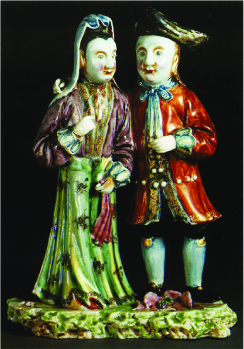
A majority of their pieces reflect an interest in cross-cultural contacts because that was the story of their lives. Rafi Y. Mottahedeh was born in 1901 in the central Persian town of Kashan, famous for its calligraphers, its rugs and its silk and gold brocade, the cloth that formed the heart of my great-grandfather’s business. The upheaval in Persia in the late teens and early twenties destroyed the family business. My father, who had saved $500, read in a newspaper that in New York one could work in the day and study at night. He left Persia, crossed the newly formed Soviet Union, and took a ship from Hamburg that arrived in New York in 1925. He immediately started night school at New York University.
To pay his costs, he was ready to try all sorts of jobs, such as waiting on tables, or drilling with a jackhammer, that were available to new immigrants. Soon, he decided to use his knowledge of Persian and Arabic to advance himself. He went to the editors of the Scott Postage Stamp Catalogue and offered to read and classify Persian stamps on which subject he soon became an authority. He also went to the Metropolitan Museum of Art where his offer to read the Persian and Arabic inscriptions was welcomed by the Curator of Islamic art, Maurice Dimand. My father also started importing contemporary Persian pottery and brass, as well as some Persian antiquities ranging from Luristan bronzes to Qujar wall tiles.
Mildred, junior member of a prominent decorating firm, went to Rafi’s office at 225 Fifth Avenue to buy some Persian “accessories”. It was at least affection at first sight, which became the full-blown love when they discovered that they were hopeless at ballroom dancing and shared a deep interest in objects.
After their marriage in 1929, it became clear that my father was the scholarly partner who also understood business finances. My mother was the artistic partner with the eye for design and winning manner with people. She had been born in Seabright, New Jersey, in 1908. From her childhood she had been fascinated by the aesthetics of non-Western cultures.
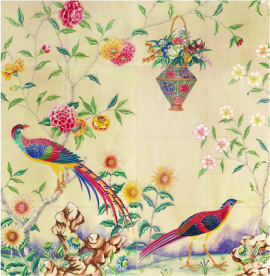
My mother quickly threw herself into reviving Persian handicrafts for sale at Mottahedeh, and from my father’s growing library on the subject, they began commissioning designs. The results were generally successful. Each of them made a buying trip to Persia in the ‘30’s and one unexpected result of these trips was the realization that Persia was a treasure trove of European and Chinese antiques.
Persian merchants, whose shops had recently acquired electric lights, were pleased that a firm in New York wished to purchase the 18th and 19th century candelabra that they no longer needed. Persians also wanted to sell the large celadon and blue and white Chinese platters on which their fathers had served rice. Along with these items came some European porcelains and a Chinese plate with the most unexpected central design – the coat of arms of the State of New York. My parents began to teach themselves yet another area of the decorative arts – European and Chinese export porcelain. Chinese export porcelain turned out to be the huge and largely unexplored field that truly suited their tastes.
After World War II, as taxes and death duties caused many European families to put their collections of porcelain on the market, yet again great quantities of porcelain passed through their hands. But it was the Chinese export porcelain that they kept, ever winnowing out less interesting pieces and adding pieces that reflected their interests: animal figures, religious subjects, and subjects that went back and forth between East Asia and Europe.
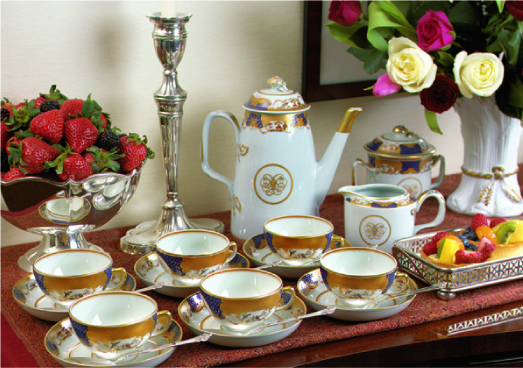
By the late fifties, they had begun to make reproductions from their own collections. They scoured Europe, East Asia and South Asia looking for craft traditions still capable of reproducing the porcelain and other accessories from the 18th century. Not surprisingly, Mottahedeh offered the most faithful as well as the most interesting reproductions.
The sixties and early seventies saw the family firm become one of the most important sources for museum reproductions. Many curators knew the quality of Mottahedeh reproductions and sought my parents – and particularly my mother’s advice – on what to reproduce from their collections. Yet my parents’ business with reproductions never dampened their taste for collecting. They combined the catalogs of dealers and made more trips to East Asia, where they found not only examples of export porcelain, but also the basics for a fine collection of Chinese archaic art.
Rafi arranged for and lived to see the publication of the Mottahedeh Chinese export porcelain collection in China for the West by two leading specialists, John Ayers and David Howard. My father’s untimely death in 1978 in no way slowed down the family business, which probably produced twice as many patterns a year as before. My mother received recognition from all sides. She was twice honored by the industry as winner of the “International Tabletop Award” and received many other awards as well. She was also the subject of many articles in magazines and newspapers such as Forbes and The New York Times.

Yet Mildred’s years after Rafi’s death were not as prosperous. Her impulse to collect remained strong. She read sales catalogues avidly and bought an occasional piece of antique porcelain as a model for reproduction, but the collection stopped growing. She sold most of the archaic Chinese art and some of the porcelain collection. Nevertheless, she held on to the main part of the Chinese export collection which she took great pride in showing to her many guests.
My mother approached old age with the same unfailing cheerfulness she had shown all her life. Even at the age of ninety, she managed to find the strength to make a trip to the Middle East with her grandson. Mildred died suddenly on February 17th, 2000. A remarkable variety of people sent letters of condolence including both a former First Lady of the United States and school children who studied at the schools she and Rafi established around the world.
My parents were learned collectors, manufacturers of faithful reproductions, and dealers who had gained a fingertip feel for their subject from the great variety of antiquities they bought and sold. These separate roles gave them a certain perspective on what they did. They believed that the universal need to eat was transformed by the arts of the table which could make eating enjoyable to the eyes and other senses. They also believed that, by reviving the best of the past through collecting and reproduction, they fostered the dialog between contemporary design and the past. In this last endeavor they were totally successful, as the great respect for both their collections and their reproductions shows.
More About Rafi Mottahedeh
My father, Rafi Y. Mottahedeh, was born in 1901 in Kashan, a city in the center of Iran famous since the 13th century for its silk brocades and stunning pottery. He left Iran in 1924 and reached New York in 1925 where he studied at New York University while doing every sort of work to support himself. He went to Maurice Dimand, a young Associate Curator at the Metropolitan Museum of Art, soon to become the Curator of Near Eastern Art, and offered his services as a translator of inscriptions and texts in Arabic and Persian. They formed a friendship through which my father received his first serious education in Islamic art. He began importing pre-modern objects as well as some contemporary pottery and textiles from Persia (which later became known as Iran to Americans). Over the years he donated many pieces of art to the Met, and in 1960s Mottahedeh reproductions of 18th century porcelain became a staple item in Met’s Gift Shop and Sales Catalogue. Rafi Y. Mottahedeh was elected a life member of the Metropolitan Museum.
My father was a modest, polite, and kindly man whose scholarly disposition laid the foundation for his business success. He had a wonderful memory of objects he had seen and read constantly about the fields in which he collected. He also regularly attended lectures at the American Institute for Persian Art and Archaeology in New York, founded by Arthur Upham Pope in 1928 (later, The Asia Institute). Pope included some of my father’s pieces in his monumental work, A Survey of Persian Art published in 1938 (lots 203 and 204), as well as in the Exhibition of Persian Art mounted by Pope’s wife, Phyllis Ackerman, in New York in 1940.
In the 1930s and 40s my father’s abundant sales to big department stores in the United States , such as Macy’s, Wanamaker’s, and Marshall Field’s, contributed to the vogue for “Things Persian,” which was the motto of his firm in its early years. Among his imports were Safavid and Qajar tile panels, some of which were incorporated by Doris Duke into her famous gardens. In this period my father also began collecting Islamic art. Although his collecting interests moved on to other areas, he continued to buy important objects such as the Kashan lustre ware bowl (lot 228) that he gave to me because of my interest in Iranian history. He had already given me many of the Islamic objects in his collection when I was a young professor at Princeton. The doyen of Islamic art historians, Richard Ettinghausen, asked to include my pieces in a seminar that he taught at Princeton in the spring of 1973. Many of these were later included in an exhibition by Ettinghausen at The Art Museum of Princeton University in 1974. When he visited me that year, my father was proud to see many pieces of the Islamic art he had given me in that show.
A few years later my father had the vision to publish his collection of Chinese export porcelain. His friend Nelson Rockefeller insisted on writing a foreword in which he called the collection “utterly fabulous, an artistic and cultural treasure without comparison in its field.” My father had the pleasure of reading the proofs of China for the West before he died in 1978.
Past Forward at Mottahedeh
In 1991, at the age of eighty-two, Mildred determined to look for a buyer. At her advanced age, she was looking to pass on her views, knowledge, love of porcelain and associations with the various historical foundations. She was ready to make a change, but intending to continue working for as long as she was able.
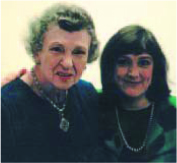
The lives of Wendy Kvalheim and Mildred Mottahedeh converged at many points over the years. Mildred was like a grand great-aunt to Wendy. She and Rafi were friends with Wendy’s grandparents long before she was born, and then with her parents through common bonds. It was this relationship and Wendy’s passion for creating reproductions from original antiquities for people to enjoy and use today that was the stimulus for Wendy to step in at the time Mildred decided to look for a buyer for her beloved company. It was agreed that Mildred would continue to work for five years. She would pass on her knowledge and collaborate in the further development of the then 68-year old company. The transfer of company ownership to Wendy Kvalheim took place in 1992.
With a degree in Fine Arts from the Pratt Institute of Fine Arts in New York, and a Bachelor of Arts from Mount Holyoke College, it’s understandable that Wendy is able to spot design directions and anticipate trends. “At Pratt I studied casting, glazing, and technical aspects of making reproductions from antique originals because I wanted to do museum work; I also wanted to be a sculptor.” With an artist’s understanding of color and a sculptor’s knowledge of casting, Kvalheim immediately understood the depth and complexity of Mottahedeh’s many designs.
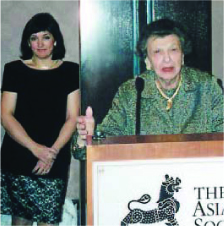
Since 1992, Wendy Kvalheim continues to build on the company’s finest traditions, while forging new directions to ensure the growth and solid future of Mottahedeh. World renowned as one of the finest manufacturers of high-fire porcelain, Mottahedeh has been in business for over 90 years. Their reputation for fine museum reproductions and numerous historic licensing agreements is unparalleled. Yet, in the last several years, a number of new products have been introduced that expand Mottahedeh’s traditional standing. The vision is Wendy Kvalheim’s, and significantly extends Mottahedeh’s points of interest.
When Mrs. Mottahedeh retired in 1997, Kvalheim continued her role as Director of Design, as well as becoming the company’s CEO. While Mrs. Mottahedeh’s enthusiasm was for antique porcelains and museum quality collections, as an artist and sculptor, Kvalheim’s interests are broader and more eclectic. Subtly she has refocused Mottahedeh’s reputation from that of a company known chiefly for their historic licensing agreements and museum commissions, to a company whose forte, first and foremost, is great design.

Mottahedeh continues to license dinner and giftware lines for the Colonial Williamsburg, Winterthur, Historic Charleston and Mount Vernon. Continuing Mildred Mottahedeh’s tradition of reproducing notable items from her own private collection, a reproduction of a Ch’ ien Lung bowl purchased by the Kvalheim’s at Christie’s is time tested beautiful Mottahedeh offering.
Building on the best of the past while preparing Mottahedeh for the future, Wendy Kvalheim assures upcoming generations the possibility of owning finely crafted high-fire porcelains and fine china, in beautiful patterns, of historic note and provenance.






